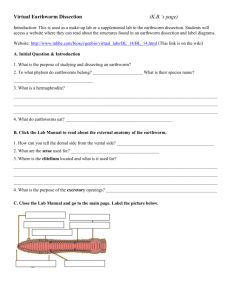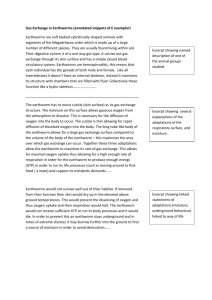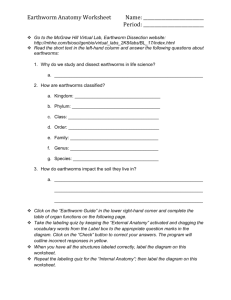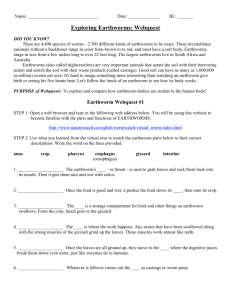Earthworm
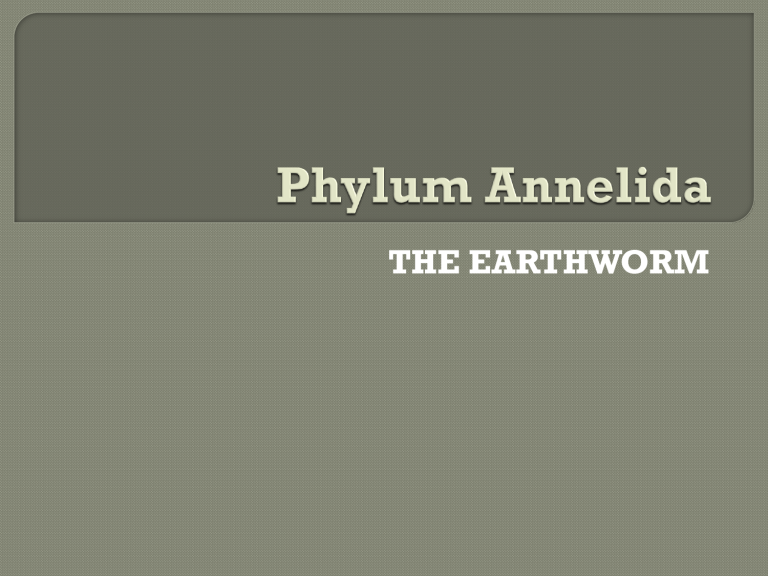
THE EARTHWORM
Large, muscular tubes that alternately contract and relax, keeping the blood flowing,
A swelling that produces a protec6tive slime ring that covers the fertilized eggs as they are laid
Muscles used to make the body longer by tightening
Muscles that when contracted shorten the body
Throat cavity; used by earthworms to suck in soil
Tube like structure through which soil and food particles pass
A round organ used to temporarily store food
A muscular organ containing grains of sand used to
Openings where sperm cells are received; the sperm cells will fertilize eggs grind up food
One of many openings through which wastes are passed to the outside of the body
Bristles used for locomation
Lumbricus terrestris is the scientific name of the common earthworm.
An earthworm does not have a separate head or any visible sense organs.
For purposes of studying earthworms, biologists assign numbers to the body segments.
Segment number 1 is found at the anterior end (mouth end).
Segments 1-12
1. Prostomium 8. Dorsal blood vessel
2. Mouth 9. Ventral blood vessel
3. Buccal cavity 10. Aortic arches
4. Pharynx 11. Suprapharyngeal ganglion
5. Esophagus 12. Circumphar. connective
6. Nephridia
7. Seminal vesicles
13. Ventral nerve cord
Segments 3-22
1. Esophagus
2. Crop
3. Gizzard
4. Intestine
6. Dorsal blood vessel
7. Ventral blood vessel
8. Ventral nerve cord
9. Setae
5. Chloragogue cells 10. Seminal vesicles
A distinct swelling involved in reproduction called the clitellum is found at earthworm segments 32-37.
The complicated organs of the digestive system take up most of the anterior half of the earthworm’s body.
Since it has no jaws or teeth, the earthworm uses its muscular pharynx to suck in soil.
The earthworm ingests large amounts of soil, which has organic matter in it.
The food particles and soil go through a tubelike esophagus into a round organ called a crop.
The crop stores the food temporarily.
• Other animals with a crop:
Birds
Food leaving the crop is forced in a very muscular organ called the gizzard.
What does it do?
• Contracting and expanding of the gizzard grinds up organic matter into smaller pieces so digestion can occur.
Food is digested in the intestine (segment 19 to end) and the digested food is absorbed by the blood circulating through the intestinal wall.
Earthworms have a circulatory system comparable to higher, more complex animals. They are said to have a closed circulatory system.
What is a closed circulatory system?
• A system in which blood is contained within a network of blood vessels.
Even though they have the kind of circulatory system found in many higher animals, it is just a simple version of it.
For instance, their aortic arches, which are comparable to our heart, do not contain any chambers or valves.
What is an open circulatory system?
•
•
• A system in which blood is not always contained within a network of blood vessels
What type of organisms do you think have open circulatory systems?
Mollusks and arthropods are groups of animals that have an open circulatory system.
How do earthworms breathe?
• A thin skin enables worm to absorb oxygen and give off carbon dioxide – diffusion
Why must their skin be kept moist?
• Diffusion or exchange of gases will not occur if worm is not moist
How do they keep their skin moist?
• A mucus is secreted by the epidermis (skin cells)
Wastes are passed to the outside of the body through nephridia.
There are two nephridia in each segment except the first three and the last.
Each nephridium does the same kind of work that a kidney does in a mammal.
A large collection of nerve cells called the cerebral ganglion functions as the brain of the earthworm.
Though the earthworm does not have eyes or ears, it is sensitive to light and vibrations.
Other receptors sensitive to touch, chemicals, and changes in temperature are scattered through the epidermis
(skin).
To shorten its body, the earthworm contracts its lengthwise or longitudinal muscles. To lengthen its body, the earthworm contracts its circular muscles.
Earthworms are hemaphroditic, but they do not self-fertilize.
The earthworm stores its sperm in sacs called seminal vesicles, located in segments 9, 10 and 11.
Eggs are produced in a pair of small ovaries in segment 13.
During sexual reproduction, two earthworms lie next to each other and swap sperm.
The sperm from one worm enters the other and is collected and stored in seminal receptacle.
Sperm leaving the seminal receptacles is put into a slim ring produced by the clitellum (swelling).
The eggs will be fertilized in the slime ring, which will slip off the body and protect the young worms as they develop.
